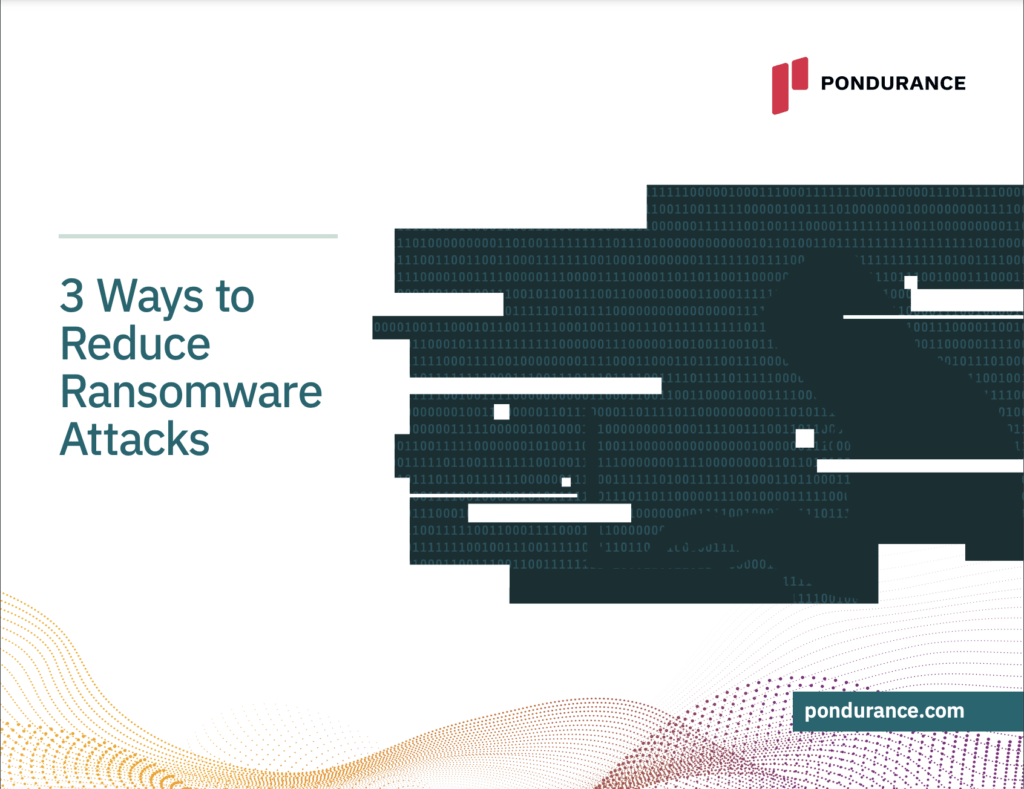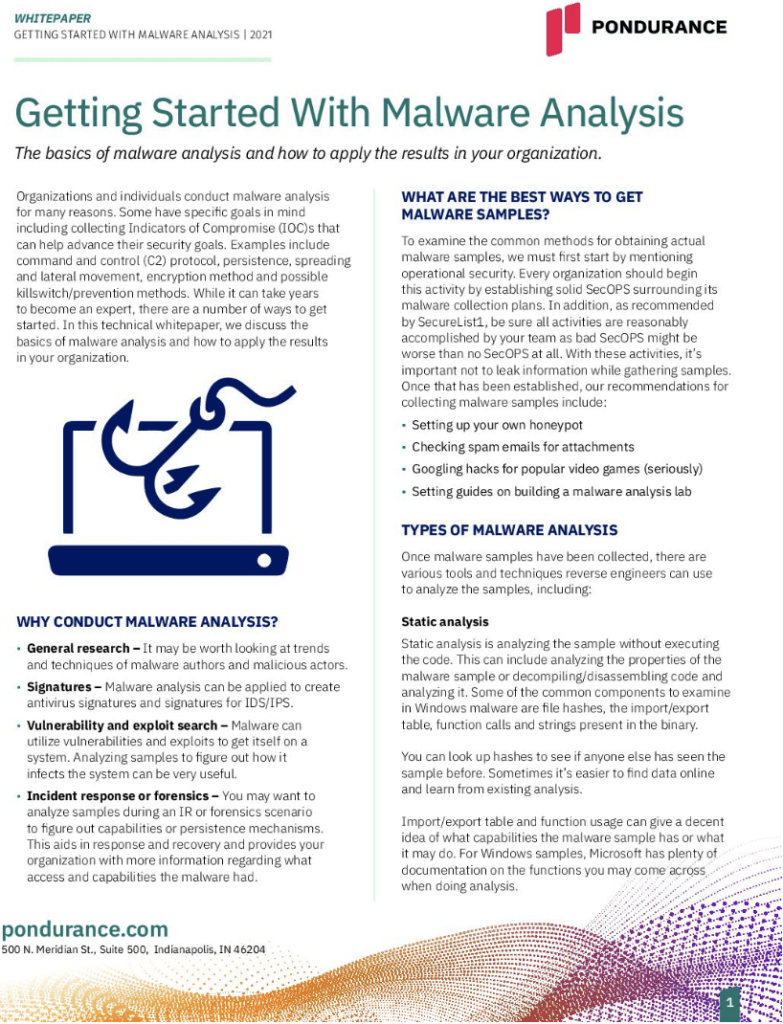Our privacy policy is located here.
Common Attack Vectors
And Keys to Protecting Your Business
Pondurance Takes a Risk-Based Approach to Threat Intelligence
We prioritize and hunt for threats that impact your organization the most.
Ransomware
- Keep all computers and devices patched
- Enable MFA
- Limit user access
- Allow only authorized applications
- Use network segmentation
- Limit remote access as much as possible
- Establish 360-degree visibility
- Monitor and analyze logs
- Provide consistent security awareness training
- Encrypt endpoints
Identify. Prioritize. Protect.
Malware
- Install reputable antivirus software and ensure it remains up to date
- Regularly update your operating system and all installed applications
- Enable built-in firewalls on your devices
- Be cautious of email attachments and links from unknown sources
- Utilize strong passwords and enable multifactor authentication (MFA) where possible
- Create regular backups of your important files and store them securely offsite
- Employee training – Educate staff members about potential threats such as phishing emails and social engineering tactics employed by cybercriminals
- Network segmentation – Divide your organization’s network into separate zones to minimize the spread of malware should an attack occur
- Vulnerability management – Regularly assess, identify, and remediate vulnerabilities in your IT infrastructure before they can be exploited by attackers
- Incident response planning – Develop a well-defined incident response plan outlining roles, responsibilities, and procedures to follow when faced with a security breach
Phishing
Additional Phishing Resources
Spear Phishing
Additional Spear Phishing Resources
Business Email Compromise (BEC)
Additional BEC Resources
Threat Intelligence
Threat intelligence represents one of the most crucial pillars in the realm of cybersecurity. In an ever-connected and digital world, organizations are constantly faced with a myriad of cyber threats. As digitization continues to engulf society, the potential risks continue to grow, demonstrating the importance of risk management strategies based on advanced cybersecurity threat intelligence. Critically, threat intelligence serves to identify, analyze and mitigate potential threats before they materialize, providing a proactive approach to protect sensitive data, infrastructures, and systems.
In essence, threat intelligence is strategized information that deals with potential or existing cyber threats that may harm an organization. This is accomplished by thorough collection, proactive analysis, and distribution of information about emerging or existing threats and malware threats. A reliable threat intelligence company crucially acts as an indispensable partner, aiding organizations to secure itself from an increasingly dangerous cyber world.
Coupling a professional threat intelligence company with a robust threat intelligence platform can deliver profound and advanced defensive capabilities. Such a platform compiles data from various sources, enforces automated analysis on the accumulated data, and provides actionable insights based on the analysis. This helps organizations to understand and prepare for both the existing and potential threats which in-turn allows for informed decision-making about security protocols, infrastructure, and strategies.
The specialized services from a threat intelligence company range from analyzing real-time threats to conducting in-depth studies on trends in cybercrime. Often bolstered with machine learning and artificial intelligence, these threat intelligence services equip organizations with predictive techniques to correlate trends, detect anomalies, and identify patterns in user behavior and network traffic. These methodologies are implemented to detect, prevent and respond to threats, thereby enhancing the cybersecurity posture of the organization.
Pondurance represents a reliable choice in acquiring threat intelligence services. The company provides a holistic range of services integrated with advanced analytics, prompt threat detection and response, thereby minimizing the time taken to mitigate an attack or threat. It follows a comprehensive approach to cybersecurity, incorporating key elements of threat intelligence into their service suite and actively empowering their clientele with the ability to anticipate and defend against cyber threats.
An essential element of threat intelligence is the threat intelligence lifecycle stages that involves planning, collection, analysis, and dissemination. The planning stage highlights what a particular organization needs to protect, the potential perils, and assigns key intelligence indicators. Following it, the collection phase amasses data from numerous sources including, open web, dark web, and internal threats. Subsequently, the analysis phase organizes and assesses this information, collaborating with artificial intelligence to make sense of an overwhelming volume of data. Finally, the dissemination stage delivers these actionable insights for implementation or formulating effective strategies against potential threats.
Cyber threat intelligence is undeniably a vital prerequisite for companies to shield themselves from the relentless onslaught of potential cyber threats. Apart from merely protecting against harsh financial repercussions, it also aids in safeguarding a company’s reputation, further emphasizing its increasing importance. By collaborating with a proven cybersecurity company like Pondurance who operationalize threat intelligence as part of their managed detection and response services, businesses can ensure they are well fortified against cyber threats and securely navigate the complex contours of the cyber landscape.
Threat Intelligence Lifecycle Explained
Threat intelligence represents a critical component in the cybersecurity landscape. This concept, which revolves around the systematic gathering, analysis, and dissemination of information concerning cyber threats, offers businesses an added layer of protection against potential attacks. The focus of threat intelligence is to understand the strategies, resources, and intentions of potential threat actors. By anticipating these potential threats, businesses can implement preventative measures.
The threat intelligence lifecycle is an essential part of this cybersecurity strategy. It is a process with several stages including collection, processing, analysis, dissemination, and feedback. It starts with the collection phase, where data about potential threats is gathered from various sources. This data is then processed into an understandable format before it’s analyzed to identify trends and patterns.
The strategic threat intelligence stage comes into play in the analysis phase. Here, the data is dissected and further studied to predict and mitigate future cyber threats. Following analysis, the information is disseminated to relevant teams within the organization who can utilize it in decision-making processes. Finally, the feedback stage entails the evaluation of the threat intelligence process and its effectiveness to enable constant improvement.
The cyber threat intelligence framework, and more specifically the threat intelligence lifecycle, aligns with the guidelines provided by the National Institute of Standards and Technology (NIST). NIST standards provide a structure for creating a comprehensive cybersecurity program, and threat intelligence plays a vital role within this framework by helping businesses anticipate, deter, and counter security threats.
One of the organizations at the forefront of utilizing threat intelligence and cybersecurity threat hunting in its cybersecurity approach is Pondurance. This firm employs a technologically advanced framework to gather, analyze, and utilize strategic threat intelligence. As a result, this robust intelligence lifecycle assists Pondurance in remaining two-steps ahead of potential cyber threats, bolstering the cybersecurity of the businesses they partner with.
Cybersecurity Threat Intelligence
Delving into the bind of cybersecurity threat intelligence, it is crucial to understand this roux of modern technology that organizations, like Pondurance, employ to bolster their managed detection and response, incident response and other professional services offered to their clients. Threat intelligence, in the realm of cybersecurity, refers to organized, analyzed, and refined data about potential or current attacks on an organization’s IT environment. By understanding and gauging the intricacies of cybersecurity threats, a swift analysis of the potential risks involved empowers firms to avert these threats and safeguard their cyber ecosystems with diligence.
The intricate nature of cybersecurity threat intelligence unfolds in an organized lifecycle. This cycle initiates with the ‘planning and direction’ phase, which involves determining the requirements of threat intelligence. This is followed by the ‘collection’ phase wherein data about potential threats are gathered from various sources. The ‘processing’ phase then validates this data and makes it ready for further analysis. Next, the ‘analysis’ phase makes sense of the raw data by combining it with background pegs of precedence and context, offering a clear understanding of the threats. The final ‘dissemination’ phase sends the intelligence to those that need it, including threat hunting professionals and automated systems.
The pool of these threat hunters is essential in the framework of cybersecurity, rendering their insights on these threats invaluable. These cyber sleuths proactively seek out lurking threats, often undetected by traditional security measures, and push the boundaries to cripple these threats even before they hatch. Companies, like Pondurance, operationalizing cyber threat intelligence into their managed detection and response services, lean on the expertise of these hunters to reinforce digital boundaries and avert potential cyber calamities for their clients.
Rooted in this dynamic spectrum of cybersecurity threat intelligence are the essential threat intelligence tools. These tools, ranging from premium ones to open-source software, aid organizations in automate data collection, parse information to sort out potential threats, and provide an active response to mitigate attacks.
Notably, the essence of threat intelligence feeds has an unmistakable bearing on threat detection. These feeds, offering a continuous stream of data about new or evolving threats, are integral to optimized threat intelligence. Whether it is free feeds, woolgathered through open-source intelligence, or top-rated paid feeds for a more comprehensive data set, these feeds energize threat detection, helping organizations devise proactive security responses.
By saddling the arsenal of cybersecurity threat intelligence, companies like Pondurance affirm their mission to neutralize threats and maintain the sanctity of an organization’s digital landscape. Yet, the ongoing evolution of threats strikes the necessity of remaining nimble and orchestrated in approach, relying on finely tuned threat intelligence feeds and factoring in the ingenuity of threat hunters.
Gone are the days when cybersecurity threat intelligence was considered an optional layer of defense for companies. It is now a crucial element in safeguarding organizations against cyber threats and protecting their reputation. Partnering with specialized firms like Pondurance, which incorporate threat intelligence into their managed detection and response services, can empower businesses to navigate the intricate world of cybersecurity with confidence and resilience. Cyber threat intelligence is no longer just a “nice-to-have” feature; it is a necessity in today’s digital landscape.

